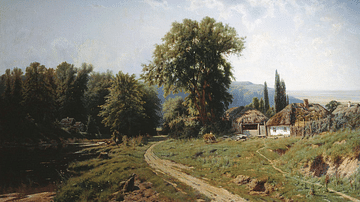Peter I of Russia (Peter the Great, l. 1672-1725) was the Tsar of Russia from 1682 to 1721 and the Emperor of Russia from 1721-1725. The lasting impression of Peter's long reign is the significant changes he brought to Russia due to his various reforms that transformed every aspect of Russian life.
Peter's reforms were influenced by a few major events in his life. These include his trips to the town of Arkhangelsk from 1693 to 1694, which lies on the White Sea and significantly increased his love for the sea and his desire to have a whole navy. The second event was the Azov Campaigns (1695-1696), in which Peter got his first experience of war and all that came with leading an army. The third event was Peter's epic voyage throughout Western Europe, which is known as the Grand Embassy. Peter travelled incognito, which allowed him to observe the daily life of countries including England, the Netherlands, and Austria. This trip gave him many new ideas on how to make Russia as strong and powerful as other European nations, and Peter returned to Russia feeling inspired.
This period of reformation was challenging for the Russian people, who found their traditions and ways of life turned upside down by Peter, who was determined and passionate about transforming Russia forever.
Remodelling the Army
One of the first things Peter turned his attention to was remodelling his whole army. He was well aware that the army needed to be modernised if they wanted to be on equal footing with the strong armies of Europe. He formed new regiments and abolished their traditional costumes, replacing them with modern uniforms. In Peter's mind, replacing the old with the new would free the men from old ideas and traditions and encourage a more modern mindset. Any men who showed some form of disobedience or resistance were sent away or killed. Peter replaced those men with sons of the nobility – men he knew would be loyal to him.
Clothing & Appearance
The traditional fashion of the Russian people was long, heavy gowns, which looked dated and were a nuisance to wear, especially for those involved in physical labour. Peter introduced a more Western European style of dress. He also forced men to shave their long beards and moustaches. Facing a lot of resistance to this regulation, in 1698, he imposed a tax on the men refusing to shave their facial hair; upper-class men were required to pay 100 rubles a year, while the lower class had to pay a penny every time they entered a town with facial hair.
He did a similar thing regarding the fashion. If a man tried to enter a town wearing a long gown, he would have to pay a fine, or they had part of their clothing cut off to make it shorter. Most men preferred to pay the tax rather than comply with these new rules. This act of defiance shows how attached they were to their old traditions.
The Church
Peter started reforming the church as early as 1700; however, it took decades to make changes that would become permanent. In 1701, Peter made changes to the monasteries by forming the Monastery Office. This office managed the monasteries, limited their spendings, and improved the standards of education. Reducing the number of monasteries, he converted all monasteries with less than 30 monks into schools or churches.
The Patriarch was the head of the Russian Orthodox Church and exerted great power and influence. However, Peter was weary that this influence could jeopardise his reign, and he wanted the church to be more under his control. Peter decided that an ecclesiastical college would be the best way to govern the church instead of a Patriarch. In 1718, he brought Feofan Prokopovich, a bishop, to St. Petersburg and made him his Chief Ecclesiastical Advisor. The Spiritual Regulation was established in January 1721, which led to the Holy Governing Synod. The Holy Governing Synod was responsible for all the affairs of the Russian Orthodox Church, including spreading the gospel, fighting against superstition, establishing educational institutions for priests, and reshaping the curriculum for religious schools.
Peter was aware that many people did not attend church, so he put out a decree that all able-bodied people would worship multiple times on Sundays and Holy Feast Days. Those who failed to attend or caused a disturbance during mass would have to pay a fine.
Welcoming Foreigners & Splitting the Empire
In 1702, Peter introduced an edict that welcomed foreigners of all religious beliefs to Russia. In Moscow, three Scottish professors oversaw a school of navigation and mathematics, while another school taught ancient and modern languages. Translations and educational texts were made in Moscow, and the first Russian newspaper was published in 1703, with a public theatre being opened in the Kremlin.

In 1708, Peter split the whole empire into eight separate governorates:
- St. Petersburg
- Moscow
- Archangelgorod
- Siberia
- Azov
- Smolensk
- Kiev
- Kazan
Prominent men were put at the head of each governorate. One of the key responsibilities of these governors was to collect the revenue of its citizens, which was no easy feat due to the high taxes. Over time, the governors began frauding the citizens, and Peter decided that another governing body would be needed.
Russia operated with a household tax, which was determined by the number of houses and land a person owned. This caused overcrowding in residences as people tried to avoid getting taxed. After a new census took place in 1710, Peter was shocked to see how the population had decreased and knew he would have a hard time collecting taxes. After returning from France, he decided to replace the household tax with an individual tax. This new tax would consist of a unit known as the 'soul.' Every male, from babies to the elderly, would have to pay this tax. Of course, exceptions were made for the nobles and church officials. While this new tax helped improve Russia's revenue, it also placed more of a financial burden on the peasants. However, it lasted for over 100 years.
The Senate
A Senate was established at the beginning of 1711, which would govern the country while Peter was away. It was made up of nine senators, and the people were given strict orders to obey these senators. The Senate was given great powers, which included ruling the provincial governments, overseeing the justice system, and taking charge of all the state expenditures. The Senate became the chief executive of the Russian government, in which nothing could be done without the Senate's consent. Peter's lieutenants could send orders to the Senate on behalf of Peter, but they were also expected to obey the Senate, which caused some confusion and conflict.
Peter soon became frustrated with the Senate and their lack of action on certain things. In 1715, Peter established the Inspector General of Decrees, whose job was to supervise the Senate. New rules for the Senate were introduced in 1720. Eventually, it became apparent that the Inspector General could not control the Senate. The officers of the Guards were assigned to oversee the Senate. If a senator caused any trouble, they would be arrested and confined in the Peter and Paul Fortress.

Peter soon realised that the Senate could not be fixed, especially considering that they were behind in the jobs they had to carry out. He changed the Senate's role to focus solely on the legislation of Russia. He established a new position known as the Procurator General, who was to be Peter's personal representative in the Senate.
The Colleges
Peter had learned of a new government system from Western Europe known as a system of colleges or ministries. In 1718, Peter created nine colleges that were already added to the existing government offices. These new colleges included:
- War
- Commerce
- Foreign Affairs
- Justice
- Expenditure
- Financial Control
- Revenue Collection
- Admiralty
- Mining and Manufacturing
The presidents of these colleges were friends of Peter's and became part of the Senate, while the vice presidents were often foreigners. Peter employed foreigners to visit the new colleges to ensure that they ran smoothly. Unfortunately, these colleges also ran into problems with jealousy and conflicts with the Senate, and local officials had difficulties grasping what these colleges were for.
As Peter's reign continued, he finally understood that Russia's government worked best when it was organised by laws and institutions rather than giving power to specific individuals. The Senate and colleges endured for many years, with the Senate renamed the Council of the Empire and the colleges being turned into ministries.
Municipal Reforms & The Table of Ranks
In 1720, Peter ordered the Senate to establish the General Master of Petitions, whose job was to analyse all petitions, ensure they were valid and pass them on to the relevant college. In 1722, they were given the further assignment of ensuring that manufacturers, factory workers and foreigners were not being mistreated or oppressed. He created a magistracy in St. Petersburg to serve as an example to the rest of Russia. All merchants were separated into guilds depending on their wealth and status, with members of the senior guild being allowed to be elected to the magistrate, where they could be involved with Russia's administration and economic development.
The Table of Ranks was introduced in 1722, which changed landowners' social and service conditions. It made distinctions between the military, court and civil groups and organised them into 14 different levels. Everybody started at the bottom level and worked their way up, with precedence being given to higher ranks. Promotion was not based on social status but on an individual's length of service and behaviour. Although the nobles complained about members of the lower class being able to rank above them, this was a key goal of Peter, who wanted to expand the landowning class and make honours available to everyone.
The noble titles of Russia kept their place, but they no longer held the power they once had. Peter had always placed more emphasis on ability than rank, and he believed that even the lower class or foreigners could apply for higher services. The Table of Ranks was an integral part of the social structure in the Russian Empire.
Education & Books
To Peter, education was an essential part of serving Russia. Voluntary schools had not had much luck, with schools in both Moscow and St. Petersburg only attracting a few dozen students each. So, Peter decided to make school compulsory. In 1714, he ordered that mathematics teachers should teach the children of landowners lessons in finance, figures, and geometry. He decreed that no child would be allowed to marry until they had learnt this. Understandably, this was met with opposition, and it was revoked in 1716. Instead, Peter ordered the children of landowners to go to one of three schools: an engineering, artillery, or naval academy.
In 1714, Peter also made education more accessible for those in the middle class. The children of priests and clerks should also learn geometry and figures. However, this, too, proved less successful than he had hoped, and he instead established naval and garrison schools for the middle class.
Peter collected many books throughout his life, which would help create the Russian Academy of Sciences library. His books ranged in topics from medicine to history, and he worked hard to increase the circulation of books among the Russians. The reformed alphabet, which Peter created in 1707, further helped in this regard. He was passionate about Russians becoming more educated with the help of books, libraries and museums. During his reign, Peter established the Museum of the Academy of Science, the Academy of Science, and the Russian Academy, which opened a year after his death.

Hospitals & Orphanges
Medical training and the building of hospitals were always crucial to Peter, and he built his first hospital in Moscow in 1707. He also built a large military hospital in St. Petersburg. He was determined that all Russian citizens had access to medical care, and in 1715, he decreed that all towns would have hospitals built.
Peter condemned the killing of illegitimate children, which had been a common practice in Russia until he ordered that anyone found guilty of killing a child would be executed themselves. He established homes where women could care for abandoned babies. He even had the foresight to install windows where mothers could leave their children without being seen and harassed.
Industry & Trade
Peter's first attempt at establishing a flourishing industry was establishing factories for muskets, leatherworks, textile mills, and cannon foundries. After the Great Northern War (1700-1721) had ended between Russia and Sweden, Peter turned his focus to other industries. Rather than rely on international trade, he created factories to manufacture silk, china, crystal, and velvet.
To encourage the people to get involved in industry and trade, Peter established the College of Mining and Manufacturing, which provided loans and built factories, which were then leased. One of the most booming industries happened to be the mining one. Peter had inherited around 20 iron foundries and worked hard to develop them. High-quality ores were discovered in the Urals, and by the end of Peter's reign, Russia had 21 iron and copper foundries and was the largest producer of iron in Europe.
The commercial and agricultural industries employed foreign ideas, machinery, and methods. Vines were brought from France and planted to make wine, shepherds were brought from other countries to teach people how to make wool, Dutch women taught Russian women how to use the spinning wheel, and Russian peasants started using long-handled scythes instead of short-handled sickles. Foreigners taught the Russians how to build and work paper mills, forges, glass factories, powder mills and brick kilns.
Regarding trade, Peter ordered canals to be built, which would link the rivers. He also wished for the Baltic, Caspian, Black, and White Seas to be joined to the Russian rivers – a dream he never saw come true in person, but one he set in motion nonetheless. He also had a vision for St. Petersburg to be a great centre of trade and commerce. He diverted the trade route to Neva from other ports, which caused an uproar. After much struggle and upheaval, St. Petersburg became the largest port in Russia.
Legacy of Peter's Reforms
While Peter the Great no doubt brought significant changes to all aspects of Russian life, there is also no denying that he was quite ruthless in enacting these changes. In a lot of instances, he paid no heed to what his people actually wanted, often uprooting everything they knew and turning their lives upside down. Peter's sole focus was to make Russia equal with other European superpowers. This desire only grew stronger after the Grand Embassy travelled throughout Western Europe, and he saw firsthand how other European countries operated.
Peter's reforms have been discussed and debated for centuries. His reforms are generally viewed as being brutal but very much needed to break Russia out of its old mould and bring it into the modern age. Unfortunately, this sometimes meant that in his pursuit of the 'common good', Peter seemed to forget about the needs and wants of his citizens.











